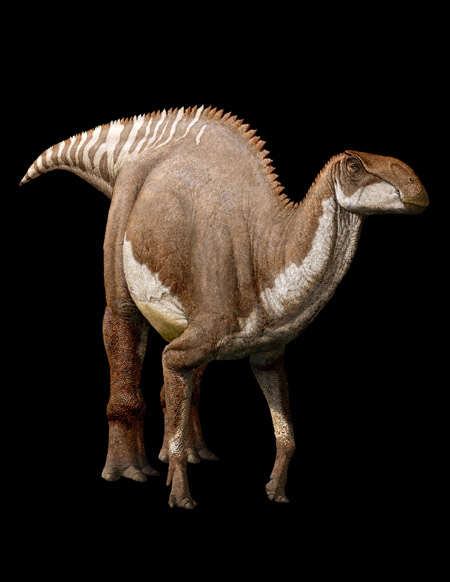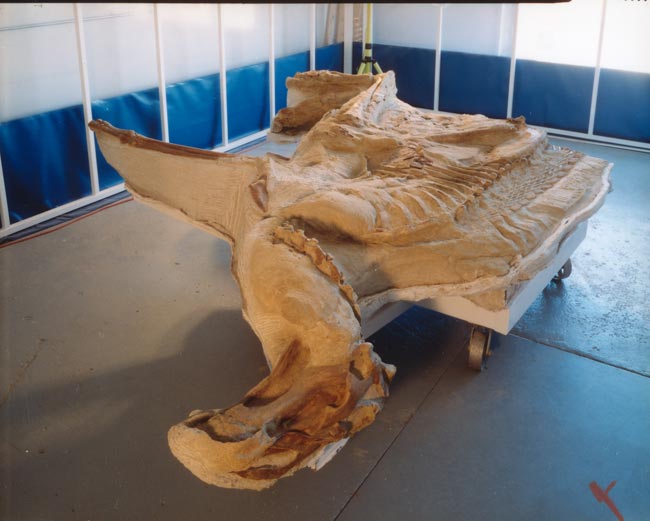Ingredients in the gut reveal the diet of dinosaurs
An analysis of the fossil's inner composition of an unusually well-preserved small dinosaur showed that the last meal included a lot of thoroughly chewed and digested leaves.
According to Justin S. Tweet, fossil Brachylophosaurus canadensis aka "Leonardo 'is the second case where the intestinal composition of a leaf-eating dinosaur is clearly demonstrated. Justin is a graduate student at the University of Colorado at Boulder. Justin made his point when studying fossils with his colleagues, including paleontologist Karen Chin.

Illustration Leonardo - 77 million year old duckbill dinosaur fossil.(Photo: Houston Natural Science Museum)
Dinosaur fossils were found in a place called Judith River Formation in Montana. It will be on public display on Friday at the Houston Museum of Natural Science. The exhibition is called 'Dinosaurs: The Cretaceous Scientific Research'.
In the September issue of the Sediment Society's PALAIOS, the authors wrote: 'Our understanding shows that the immature brachylophosaur dinosaur discovered in Judith River Formation is prepared. The main diet is leaves at the time before it dies. '
Skin and scales

According to a new Leonardo analysis - a well-preserved 77 million-year-old duck-billed dinosaur fossil - probably only eating leaves mainly.(Photo: Houston Natural Science Museum)
Leonardo is a duck-billed dinosaur that has been 77 million years old, its remains are covered with textured fossilized skin. The specimen gave scientists information on the body part of the dinosaur. Digital technology along with X-ray scanning has helped paleontologists reconstruct Leonardo's image, what it eats, muscle mass and movement of its limbs.
Analysis of the intestinal pollen of the specimen also revealed that the dinosaurs eat a variety of plants, including ferns, conifers and flowering plants. Although pollen can be ingested when dinosaurs drink water, small pieces of leaf (less than 5 mm long) indicate that Leonardo is a large leaf-eating animal.

Leather on Leonardo's arm, 77 million-year-old duck-billed dinosaur fossil.(Photo: Houston Natural Science Museum)
Hadrosaur dinosaurs are certainly capable of handling food into small pieces because they often change teeth and clench their jaws.
The analysis must show that the dinosaur's leaf in the intestine is its last meal, not from an invasive material, and the body often flows into the intestine after it dies. In fact, Leonardo was buried quickly and was not disturbed by scavengers, so his body's inner cavity seemed to remain intact. At least 12% of the intestinal matter of dead dinosaurs is of organic origin, such as leaves. The rest are clay and grit. Some inorganic substances may have flowed into the body after it died.
According to Tweet, they say the most interesting thing about research is finding the real substance in the gut.

Leonardo's body, 77 million-year-old duck-billed dinosaur fossil.(Photo: Houston Natural Science Museum)
He said: 'This is very rare for dinosaurs, we often have to generalize about their eating behavior based on skull anatomy'.
The study was funded by the University of Colorado, the Museum of Natural History, and the American Society of Geology Research Fellows.
Food crusher
In charge of paleontology, Robert T. Bakker of the Houston Museum of Natural Science, one of the scientists studying fossils, said that duck-billed dinosaurs like Leonardo had large beaks and jaws with small teeth (about 800 units). Those teeth are used to grind plants and hard food parts including needles, bark and twigs like a grinder.
The composition of the gastrointestinal tract - the intestine is processed by digestive fluids and bacteria.

Leonardo's arm.(Photo: Houston Natural Science Museum)
Leonardo has the same skin as the lower part of the African ostrich or other large birds. But in the front of her ankle and shin, the skin becomes very thick like the armor protecting it when it passes through the bushes.
The fossil was discovered in the summer of 2000 on an expedition to a cattle ranch located north of Malta, Mont. 15 miles. Leonardo was named after a graph of graphite in a nearby rock with the words: 'Leornard Webb loves Geneva Jordan 1916'.
The exhibit at the Houston Museum also features an icthyosaur dinosaur 'mummy' with an intestinal component and four baby dinosaurs inside its body, it is also the only known triceratoid skin. The opening day of the exhibition was postponed for a week due to the outage and condition of the Houston area after Hurricane Ike. Leonardo and other exhibits were not harmed.
- The nutrient-rich diet of herbivorous dinosaurs
- Discovered new carnivorous dinosaurs who once lived in the desert
- 114 million-year-old fossils reveal new 'super beasts'
- 10 weird, hard to imagine dinosaurs
- Fossils reveal information about life regeneration on Earth after extinct dinosaurs
- New lizard species in the fossil 4-wing dinosaur stomach 125 million years
- Arctic dinosaurs are only 20 years old
- 10 misconceptions about dinosaurs
- What if dinosaurs live with humans?
- How does the dinosaur learn to fly?
- 70 million years old dinosaurs
- Erotic dance of carnivorous dinosaurs
 Discovered an ancient centipede fossil 99 million years old
Discovered an ancient centipede fossil 99 million years old Discovered bat-like dinosaurs in China
Discovered bat-like dinosaurs in China Discovered a 200-year-old bronze cannon of the coast
Discovered a 200-year-old bronze cannon of the coast Discover 305 million-year-old spider fossils
Discover 305 million-year-old spider fossils